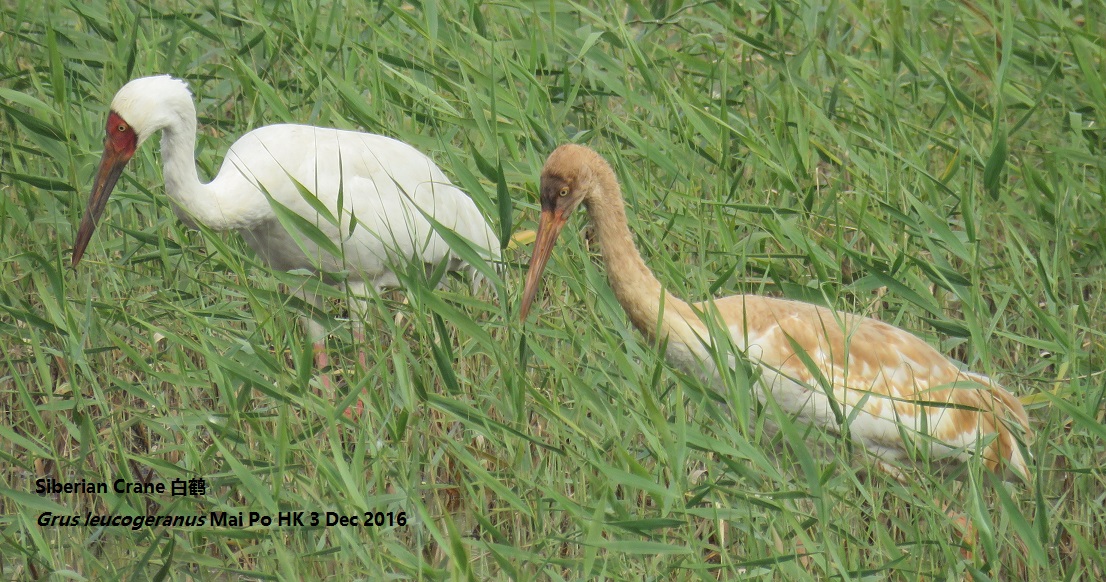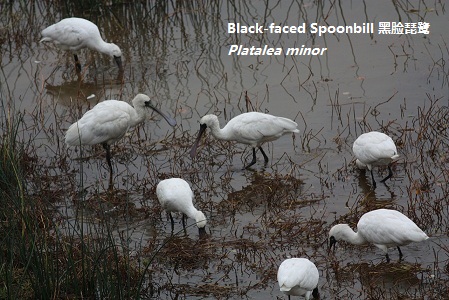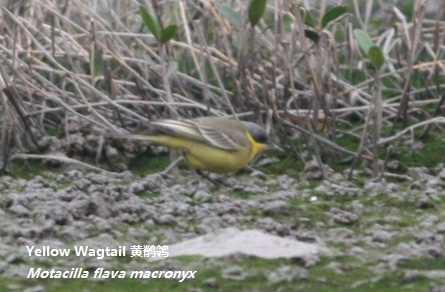Introduction
 Mai Po is quite simply the best tidal wetland reserve in south-east China and one of the best in Asia. At peak migration in April, up to 40 species of waders pass through, together with terns and an excellent selection of passerines. In winter there are up to 60,000 waterfowl including Black-faced Spoonbill, Dalmatian Pelican and a variety of gulls in Feb/March.
Mai Po is quite simply the best tidal wetland reserve in south-east China and one of the best in Asia. At peak migration in April, up to 40 species of waders pass through, together with terns and an excellent selection of passerines. In winter there are up to 60,000 waterfowl including Black-faced Spoonbill, Dalmatian Pelican and a variety of gulls in Feb/March.
Key Species
Dalmatian Pelican, European Spoonbill, Black-faced Spoonbill, Falcated Duck, Imperial Eagle, Greater Spotted Eagle, Nordmann’s Greenshank, Spoon-billed Sandpiper, Asian Dowitcher, Long-billed Dowitcher, Saunders’ Gull, Great Black-headed Gull, Heuglin’s Gull, Yellow-legged Gull.
Other Species
 Little Grebe, Great Cormorant, Purple Heron, Grey Heron, Chinese Pond Heron, Striated Heron, Black-crowned Night Heron, Cattle Egret, Little Egret, Intermediate Egret, Great Egret, Yellow Bittern, Cinnamon Bittern, White Ibis, Common Shelduck, Ruddy Shelduck, Mallard, Spot-billed Duck, Northern Pintail, Northern Shoveler, Gadwall, Eurasian Wigeon, Common Teal, Garganey, Tufted Duck, Common Pochard, Black Kite, Common Buzzard, Bonelli’s Eagle, Eastern Marsh Harrier, Osprey, Black-shouldered Kite, Kestrel, Peregrine, White-breasted Waterhen, Common Moorhen, Eurasian Coot, Slaty-breasted Rail, Pied Avocet, Black-winged Stilt, Little-ringed Plover, Kentish Plover, Greater Sandplover, Lesser Sandplover, Pacific Golden Plover, Grey Plover, Great Knot, Red Knot, Sanderling, Red-necked Stint, Temminck’s Stint, Long-toed Stint, Sharp-tailed Sandpiper, Curlew Sandpiper, Dunlin, Broad-billed Sandpiper, Ruff, Common Snipe, Long-billed Dowitcher, Black-tailed Godwit, Bar-tailed Godwit, Whimbrel, Eurasian Curlew, Far-eastern Curlew, Spotted Redshank, Common Redshank, Marsh Sandpiper, Common Greenshank, Green Sandpiper, Wood Sandpiper, Terek Sandpiper, Ruddy Turnstone, Red-necked Phalarope, Spotted Redshank, Redshank, Greenshank, Black-headed Gull, Black-tailed Gull, Slaty-backed Gull, Gull-billed Tern, Caspian Tern, Little Tern, Common Tern, Blue-tailed Bee-eater, Blue-throated Bee-eater, Pied Kingfisher, Black-capped Kingfisher, White-breasted Kingfisher, Common Kingfisher, Red-rumped Swallow, Sand Martin, Water Pipit, Richard’s Pipit, Olive-backed Pipit, Yellow Wagtail, Grey Wagtail, White Wagtail, Siberian Rubythroat, Bluethroat, Grey-backed Thrush, Japanese Thrush, Blackbird, Zitting Cisticola, Yellow-bellied Prinia, Plain Prinia, Black-browed Reed Warbler, Lanceolated Warbler, Oriental Reed Warbler, Thick-billed Warbler, Manchurian Bush Warbler, Yellow-browed Warbler, Pallas’s Leaf Warbler, Brown Shrike, Collared Crow, White-cheeked Starling, Red-billed Starling, White-shouldered Starling, Black-collared Starling, Black-faced Bunting, Little Bunting, Chestnut Bunting, Spotted Munia, White-backed Munia.
Little Grebe, Great Cormorant, Purple Heron, Grey Heron, Chinese Pond Heron, Striated Heron, Black-crowned Night Heron, Cattle Egret, Little Egret, Intermediate Egret, Great Egret, Yellow Bittern, Cinnamon Bittern, White Ibis, Common Shelduck, Ruddy Shelduck, Mallard, Spot-billed Duck, Northern Pintail, Northern Shoveler, Gadwall, Eurasian Wigeon, Common Teal, Garganey, Tufted Duck, Common Pochard, Black Kite, Common Buzzard, Bonelli’s Eagle, Eastern Marsh Harrier, Osprey, Black-shouldered Kite, Kestrel, Peregrine, White-breasted Waterhen, Common Moorhen, Eurasian Coot, Slaty-breasted Rail, Pied Avocet, Black-winged Stilt, Little-ringed Plover, Kentish Plover, Greater Sandplover, Lesser Sandplover, Pacific Golden Plover, Grey Plover, Great Knot, Red Knot, Sanderling, Red-necked Stint, Temminck’s Stint, Long-toed Stint, Sharp-tailed Sandpiper, Curlew Sandpiper, Dunlin, Broad-billed Sandpiper, Ruff, Common Snipe, Long-billed Dowitcher, Black-tailed Godwit, Bar-tailed Godwit, Whimbrel, Eurasian Curlew, Far-eastern Curlew, Spotted Redshank, Common Redshank, Marsh Sandpiper, Common Greenshank, Green Sandpiper, Wood Sandpiper, Terek Sandpiper, Ruddy Turnstone, Red-necked Phalarope, Spotted Redshank, Redshank, Greenshank, Black-headed Gull, Black-tailed Gull, Slaty-backed Gull, Gull-billed Tern, Caspian Tern, Little Tern, Common Tern, Blue-tailed Bee-eater, Blue-throated Bee-eater, Pied Kingfisher, Black-capped Kingfisher, White-breasted Kingfisher, Common Kingfisher, Red-rumped Swallow, Sand Martin, Water Pipit, Richard’s Pipit, Olive-backed Pipit, Yellow Wagtail, Grey Wagtail, White Wagtail, Siberian Rubythroat, Bluethroat, Grey-backed Thrush, Japanese Thrush, Blackbird, Zitting Cisticola, Yellow-bellied Prinia, Plain Prinia, Black-browed Reed Warbler, Lanceolated Warbler, Oriental Reed Warbler, Thick-billed Warbler, Manchurian Bush Warbler, Yellow-browed Warbler, Pallas’s Leaf Warbler, Brown Shrike, Collared Crow, White-cheeked Starling, Red-billed Starling, White-shouldered Starling, Black-collared Starling, Black-faced Bunting, Little Bunting, Chestnut Bunting, Spotted Munia, White-backed Munia.
Some videos from Mai Po: Asian Dowitcher: https://youtu.be/T_WAjSdrrvc Broad-billed Sandpiper: https://youtu.be/l3u9GreMm8I Little Stint: https://youtu.be/GFx2OkQhHd4 Nordmann's Greenshank: https://youtu.be/Tg0Fa0KTtAw Chinese Egret: https://youtu.be/2o0C7n_cHA8 Pacific Golden Plover: https://youtu.be/2kIwCFE0J78 Red Knot: https://youtu.be/SR5xSIpVC1E Red-necked Stint: https://youtu.be/IX8AG1z_ahk Sharp-tailed Sandpiper: https://youtu.be/_0tC55myJa0 Terek Sandpiper: https://youtu.be/0_TpYpUfrh4 Siberian Crane: https://youtu.be/o6Q_hHVTfhw
Other Wildlife
Leopard Cat, Small Asian Mongoose
Birding
Hirundines and swifts tend to occur in the area of ponds between the road and the Peter Scott Centre. This area and the ponds in the immediate vicinity of the centre are also good for wagtails and pipits. The casuarinas, along the path to the Education Centre, attract migrant buntings, warblers and flycatchers. The tower hide is good for a general overview of the reserve. Ponds 16/17, 11 and 8 are good for waders on migration. Birding from the boardwalk hides is the best place to pick up all the waders as well as gulls, terns and duck. Pond 20 is excellent for duck.
Habitat and Vegetation
Tidal mudflats, mangroves, gei wai (shrimp ponds), reedbeds.
Getting there
In order to be on the reserve you must first be a member of WWF HK, which can be arranged by contacting WWF HK at GPO Box 12721, Hong Kong, telephone 2526 4473, fax 2526 2667 or email to maipo@wwf.org.hk. Membership can also be arranged at the reserve shop. Remember to carry the receipt or membership card around at all times when on the reserve as spot checks are made, especially during busy times (weekends and April). In addition a permit to allow you into the wildlife protection area in which the reserve lies must be obtained in advance from: The Director, Agriculture, Fisheries and Conservation Department, 5th Floor, Cheung Sha Wan Government Offices, 303 Cheung Sha Wan Road, Kowloon, Hong Kong. Tel (852 2150 6921, fax (852) 2311 3731, e-mail: afcdenq@afcd.gen.gov.hk. Send your name, passport number and details of membership of any birdwatching societies and preferably also membership details of WWF HK. It is best to apply a month or more in advance. Permits for the reserve do not, however, allow you access to the boardwalk hides. WWF HK can arrange this on your behalf for a fee and this is probably the easiest solution. If you do it yourself directly then you will need to go in person with your passport, your reserve permit and a letter of introduction from WWF (obtainable at the Mai Po shop) to the Frontier District HQ & Sheung Shui Divisional Police Station, 1 Sha Tau Kok Road, Fanling. Do not go out to the boardwalk hide without a permit as a) you are breaking the law and b) you will threaten the continued provision of this facility for everybody else. To get to Mai Po from Sheung Shui KCR station take a taxi which will cost about HK$70 or red minibus #17 which goes to Yuen Long. Beyond San Tin a roads leads off to the right at a bend and is signposted to Mai Po Nature Reserve. It is a 10-15 minute walk to the Peter Scott Centre, which lies at the end on the left. Before entering the reserve you must present your permit to the AFCD office. If travelling by car take the highway that bypasses Sheung Shui heading toward Yuen Long. Turn off at the Fairview Park exit and drive north towards San Tin and follow the signs to Mai Po reserve. Take a left turn to the reserve from this road after a few minutes. To get back from Mai Po call a taxi from the shop in the Field Studies Centre (the staff will help you) or walk out to the main road from where you can get a red minibus back to Sheung Shui or Yuen Long. The 76K public bus also runs between Yuen Long and Sheung Shui KCR and the stop is on the right as you reach the main road. There is accommodation available at the Peter Scott Centre, located at Mai Po itself. The charge is now HK$114 per bed in the rooms with four beds and $156 per bed in the rooms with two beds. The following website has more detailed information: http://www.wwf.org.hk/eng/maipo/introduction/peterscott_booking.html
General Information
Altitude: 0-20m Disturbance: limited, though Deep Bay is increasingly polluted. However, the western corridor bridge has recently been constructed across the bay from Shekou to Nim Wan and this may impact tidal flow and increase the rate of siltation.
